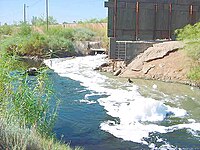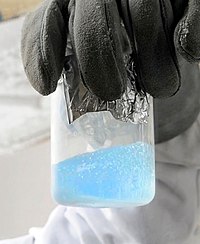
Gadolinium as a new emerging contaminant of aquatic environments.
Sign Up to like & getrecommendations! Published in 2018 at "Environmental toxicology and chemistry"
DOI: 10.1002/etc.4116
Abstract: Since the 1980s, gadolinium (Gd)-based contrast agents (GBCAs) have been routinely used in magnetic resonance imaging as stable chelates of the Gd3+ ion, without toxic effects. Generally, GBCAs are considered some of the safest contrast… read more here.
Keywords: emerging contaminant; contaminant aquatic; gadolinium new; aquatic environments ... See more keywords

Trophic Conditions Influence Widespread Distribution of Aster-Like Nanoparticles Within Aquatic Environments
Sign Up to like & getrecommendations! Published in 2020 at "Microbial Ecology"
DOI: 10.1007/s00248-020-01541-6
Abstract: Aster-like nanoparticles (ALNs) are newly described femto-entities. Their ecology (e.g., geographic distribution, spatial dynamic, preferences, forcing factors) is still unknown. Here, we report that these entities, which have largely been ignored until now, can develop… read more here.
Keywords: like nanoparticles; aster like; aquatic environments; ecology ... See more keywords

Occurrence, sources, human health impacts and mitigation of microplastic pollution
Sign Up to like & getrecommendations! Published in 2018 at "Environmental Science and Pollution Research"
DOI: 10.1007/s11356-018-3508-7
Abstract: The presence and accumulation of plastic and microplastic (MP) debris in the natural environment is of increasing concern and has become the focus of attention for many researchers. Plastic debris is a prolific, long-lived pollutant… read more here.
Keywords: pollution; occurrence sources; human health; aquatic environments ... See more keywords

Determination of nanomolar levels of reactive oxygen species in microorganisms and aquatic environments using a single nanoparticle-based optical sensor.
Sign Up to like & getrecommendations! Published in 2017 at "Analytica chimica acta"
DOI: 10.1016/j.aca.2017.03.012
Abstract: Reactive oxygen species (ROS) are strong oxidants, and have attracted considerable attention in both biological and environmental fields. Although various methods for ROS detection, including optical and electrochemical techniques, have been developed, they still face… read more here.
Keywords: reactive oxygen; optical sensor; oxygen species; aquatic environments ... See more keywords

Molecular-biological sensing in aquatic environments: recent developments and emerging capabilities.
Sign Up to like & getrecommendations! Published in 2017 at "Current opinion in biotechnology"
DOI: 10.1016/j.copbio.2016.11.022
Abstract: Aquatic microbial communities are central to biogeochemical processes that maintain Earth's habitability. However, there is a significant paucity of data collected from these species in their natural environment. To address this, a suite of ocean-deployable… read more here.
Keywords: recent developments; biological sensing; environments recent; sensing aquatic ... See more keywords

Potential of Panicum aquanticum Poir. (Poaceae) for the phytoremediation of aquatic environments contaminated by lead.
Sign Up to like & getrecommendations! Published in 2020 at "Ecotoxicology and environmental safety"
DOI: 10.1016/j.ecoenv.2020.110336
Abstract: Aquatic environments contaminated by lead (Pb) are a problem in many regions of world. Since Pb has high toxicity, the identification of species for phytoremediation is important for the recovery of these areas. Thus, the… read more here.
Keywords: environments contaminated; anatomy; poir poaceae; aquatic environments ... See more keywords

Adsorption of dissolved organic matter (DOM) on polystyrene microplastics in aquatic environments: Kinetic, isotherm and site energy distribution analysis.
Sign Up to like & getrecommendations! Published in 2020 at "Ecotoxicology and environmental safety"
DOI: 10.1016/j.ecoenv.2020.110658
Abstract: Microplastics and dissolved organic matter (DOM) are ubiquitous in aquatic environments. The adsorption behavior of DOM on microplastics in aquatic environments is a prominent concern. In this study, the adsorption of two types of DOM,… read more here.
Keywords: adsorption; dom; energy; adsorption psmps ... See more keywords

The potential of Aeromonas spp. from wildlife as antimicrobial resistance indicators in aquatic environments
Sign Up to like & getrecommendations! Published in 2020 at "Ecological Indicators"
DOI: 10.1016/j.ecolind.2020.106396
Abstract: Abstract Worldwide emergence of bacterial strains resistant to multiple classes of antimicrobials and the increase incidence of infections caused by bacteria resistant to last-resource antibiotics is now a common problematic and likely to increase in… read more here.
Keywords: resistance determinants; potential aeromonas; antimicrobial resistance; resistance ... See more keywords

Complex migration of antibiotic resistance in natural aquatic environments.
Sign Up to like & getrecommendations! Published in 2018 at "Environmental pollution"
DOI: 10.1016/j.envpol.2017.08.078
Abstract: Antibiotic resistance is a worsening global concern, and the environmental behaviors and migration patterns of antibiotic resistance genes (ARGs) have attracted considerable interest. Understanding the long-range transport of ARG pollution is crucial. In this study,… read more here.
Keywords: corresponding contaminants; complex migration; antibiotic resistance; aquatic environments ... See more keywords

Nanoplastics display strong stability in aqueous environments: Insights from aggregation behaviour and theoretical calculations.
Sign Up to like & getrecommendations! Published in 2019 at "Environmental pollution"
DOI: 10.1016/j.envpol.2019.113760
Abstract: Nanoplastics are inevitably released into aquatic environments due to their extensive use and the continuous fragmentation of plastics. Therefore, it is imperative to understand the aggregation behaviours that determine the transport and fate of nanoplastics… read more here.
Keywords: aggregation; display strong; aquatic environments; nanoplastics display ... See more keywords

A critical review of control and removal strategies for microplastics from aquatic environments
Sign Up to like & getrecommendations! Published in 2021 at "Journal of environmental chemical engineering"
DOI: 10.1016/j.jece.2021.105463
Abstract: Abstract The ubiquitous appearance of microplastics (MPs) in aquatic environments brings about a growing concern for plastic pollution. Although the MPs occurrence, transportation, fate, and impacts have been summarized thoroughly, it calls for a better… read more here.
Keywords: separation; removal; control removal; removal strategies ... See more keywords